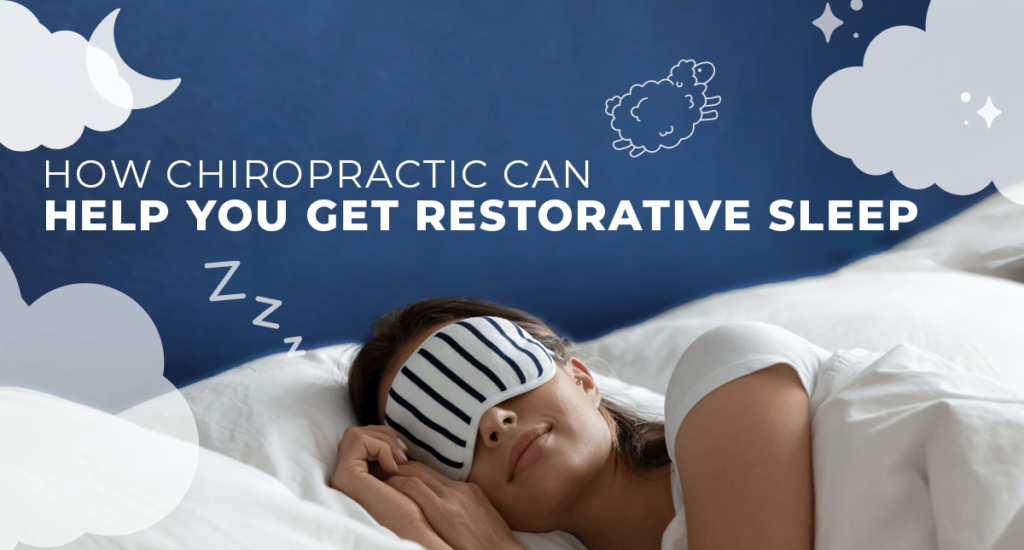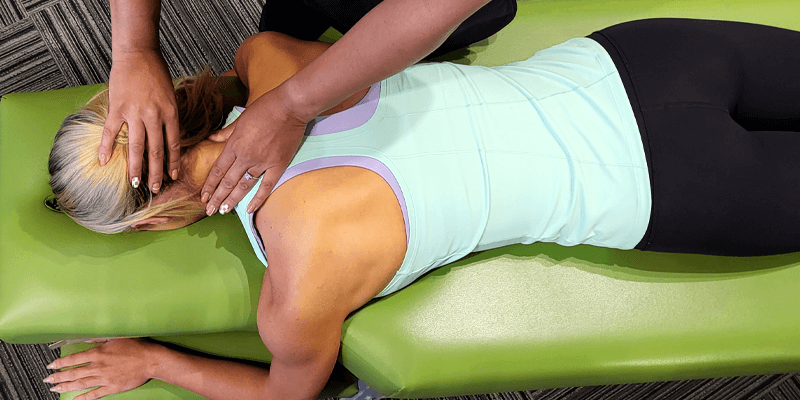
How Much Sleep Do I Really Need?
No doubt you’ve experienced an afternoon energy crash, uncontrollable yawning or the simple desire to close your eyes and rest. It may be hard to […]

Sleep apps. White noise. Meditation. Chamomile tea. Magnesium. Melatonin spray. Have you tried one or more of these in hopes of getting a good night’s sleep? If sound sleep eludes you, you’re not alone. Between 50 to 70 million Americans are not getting the sleep they need to fully recover from their day and restore their functions.
Many of them are beginning to wonder: Can chiropractic help with sleep problems? According to the National Sleep Foundation, a third of people who receive chiropractic adjustments say their sleep improves immediately. Harvard Health recommends adjustments “to relieve pain and improve function and to help the body heal itself.” The American College of Physicians also recommends chiropractic adjustments.
Discover for yourself how chiropractic care, in conjunction with good sleep hygiene, can help turn draining, poor-quality sleep into exhilarating, restorative sleep. Can chiropractic help with sleep problems, pain and tense muscles? Read on to learn exactly how this gentle therapy can help you get the restorative sleep you need to feel your best.
Restorative sleep is sleep that powers the natural brain repair you need nightly for optimal function, immune response, alertness, positive mood and enhanced sex drive. The only driver of restorative sleep is a healthy sleep-wake cycle (or circadian rhythm).
If you want to fully recover from the exertion and stress of yesterday and restore functions for tomorrow, you need to get at least 7 hours of restorative sleep. Your brain needs to alternate between 5 light and deep sleep stages: light theta wave sleep, true light theta sleep, light delta wave sleep, deep slow wave delta sleep and finally, rapid eye movement sleep (REM).
Sleeping through this cycle nightly activates your metabolism (all the chemical processes that provide your energy) like:
Can chiropractic help with sleep problems that disrupt this cycle? To answer that question, you need to understand exactly what’s disrupting your sleep and making your daily functions less than optimal.
There are myriad factors that can disrupt your sleep cycle, but researchers have established the following as the most common:
Decades worth of research has shown that chronic pain is a common contributor to poor sleep quality — over half of adults experience back pain, 38 million Americans struggle with migraines and chronic headaches, and insomnia affects over a third of us. The Neuropsychopharmacology Journal found that pain and discomfort can cause poor sleep by lowering the body’s threshold for pain.
Can chiropractic help with sleep problems? Yes, because it can help relieve and manage pain. Chiropractic for neck pain, chiropractic for shoulder pain and back pain chiropractic are common contributors to a good night’s sleep.
Difficulty falling asleep, staying asleep, and getting enough sleep to feel rested sums up insomnia. It’s a very complex condition, as its root cause can vary widely, including:
Identifying the root cause is the first step in your DC’s care plan. Can chiropractic help with sleep problems like insomnia? If pain or discomfort has been identified as the root cause, yes, chiropractic — combined with other therapeutics and lifestyle changes — can help alleviate the condition and restore sound sleep.
When mouth and throat soft tissues relax so much during sleep that they block the upper airway, a patient is diagnosed with obstructive sleep apnea (OSA). More than 22 million Americans live with some form of momentary apneas — 10-20 second pauses in inhalation — several times every hour. That’s long enough to lower oxygen levels in their blood, alerting their brain to wake up the rest of their body to restart the breathing cycle. Such disruptions (sometimes 30 per night) make it impossible to get restorative sleep and can, with time, contribute to other serious health conditions.
Your spinal cord is housed inside your spine where it’s protected by strong, bony vertebrae. As your spine shifts positions after years’ worth of falls and traumas, it brings your spinal cord with it. A misaligned spinal cord affects various areas of your body.
For decades, medical journals have been documenting how chiropractic for neck pain, chiropractic for shoulder pain and back pain chiropractic can promote the following benefits for patients with sleep disorders:

It’s easy to observe that the gentle adjustments your DC delivers to your misaligned joints can be effective at reducing your pain and relieving tight, tense muscles. Other sleep and wellness promoting functions of adjustments may not be as obvious.
Your misaligned vertebrae can put pressure on your nerves (often called “pinched nerves”), interfering with the neural communication that controls your breathing. Chiropractic realignment can correct neck curvature, mitigating that interference to improve sleep quality and even help you stop snoring (which can lead to apnea).
Misalignments and muscle tension can also increase production of your body’s stress hormone cortisol. Realigning your spine and releasing pressure from your nerves can help naturally lower your cortisol levels.
Research demonstrating these functions is continually being published in journals like:
Perusing decades worth of studies can help you conclusively answer the question ‘Can chiropractic help with sleep problems?’ Every day more chiropractors across the country are applying the latest research which shows that combining chiropractic adjustments with active therapies promotes faster, more effective injury recovery and function restoration.
Your DC can complement your back pain chiropractic adjustments, chiropractic for neck pain or chiropractic for shoulder pain with sleep hygiene recommendations, supportive mattresses, ergonomic pillows and breathing exercises to strengthen the soft tissues that cause snoring.
In order to get the minimal 7 hours of sleep you need, try following the 10-3-2-1 rule before bed:
Finally, before snuggling in, stretch in any way that’s comfortable for you, then try this 4-7-8 breathing exercise:
Just like other breathing exercises, practice this technique for a few minutes then increase the time as you get comfortable with it (you may even drift off before you can finish).
Check in with your nearest Chiro One doctor at one of our welcoming open-plan clinics across the country. They’ll explore the root cause of your pain with a thorough exam, then personalize a care plan — a combination of gentle chiropractic adjustments and active therapies.
Subscribe and get news, articles & offers sent right to your inbox each month.
"*" indicates required fields
By subscribing you are agreeing to the Terms and Conditions and Privacy Policy.